I’d begun to wonder if the sap tree along the Red Deer trail in the Riverwood Conservancy in Mississauga was too dry to crack and drip this year. In previous years, it’s been a great place to stop and look for butterflies, moths and other insects. With the near-drought this spring (2016), I wasn’t sure if the tree had enough sap for any to dampen the bark. So I was pleased to see on a visit in the first week of July that the butterflies were back and the sap tree was offering free drinks.
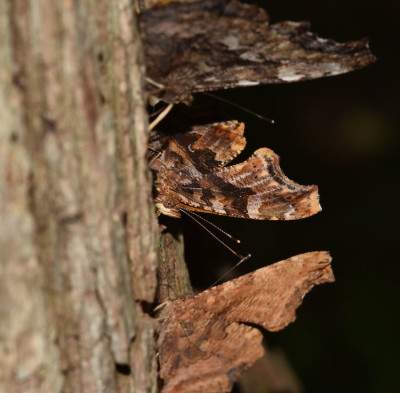
Butterflies will line up along a crack to get at the sap. At one time there were 5 all in a vertical row.
This Anglewing Butterfly Doesn’t Have a Comma or a Question Mark On the Underwing
When I was sorting through my photos at home in the afternoon, I noticed that one of the “punctuation mark” butterflies had very plain undersides to its wings. Usually there is a white comma or a white comma with a dot. This one, which was a bit larger than the other butterflies, had unmarked wings.
A Compton Tortoiseshell Or False Comma Butterfly Sets Down In Mississauga
Fortunately, it opened its wings a few times while I was watching it and I took a photo of the top side of the wings. At the time, I noticed the white dots and they really stood out when I looked at the photos again at home.
I checked my copy of The ROM Field Guide to Butterflies of Ontario for details on the different Commas and the Question Mark. I thought maybe one of the types of Commas had a subtler marking. Instead, I found a photo that matched mine: It’s a Compton Tortoiseshell, also called a “False Comma.” It is related to the Commas and the Mourning Cloak.
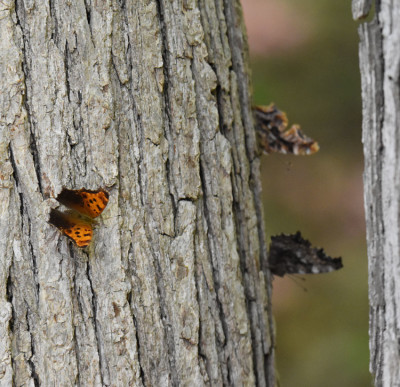
For a size comparison, here is an orange Comma walking quickly towards the crack where a different Comma or Question Mark (top) and the Compton Tortoiseshell (bottom) are already sipping.
I was very pleased to add this to my “Riverwood” collection. One by one, I’m learning the butterflies and moths that I see on my walks there. When I add one to my mental list, it gives me another creature to keep an eye out for on my rambles. For instance, I first saw a Baltimore Checkerspot near the maintenance loop. I haven’t found one there again, yet, but I keep looking!
What Kind of Sap Are These Butterflies, Moths, Wasps and Insects Flocking To Feed On?
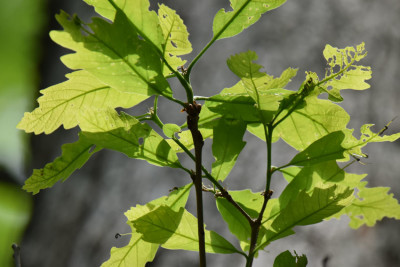
When I zoomed in on these shots on my computer, I realized I have some photos of the caterpillars busy eating all the leaves off again this year: if you click on the photo and look to the far right you’ll see one of them at work.
During the off-season for butterflies, I made a point of checking the leaves on the sap tree. It sounds like an easy thing to check but they were so few in number and so eaten by the early summer last year that I wasn’t quite sure.
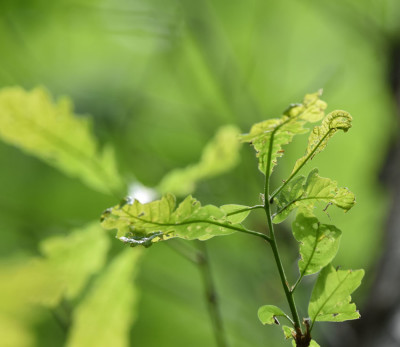
This spring I confirmed that it is an oak tree. If anyone has an opinion about the type of oak (it appears to be a White Oak) please leave a comment. I know there is a small possibility of Swamp Oaks being present in this area and there may be other types I have not even heard about.
My First Look at a Question Mark Butterfly In Mississauga This Summer–Or Not
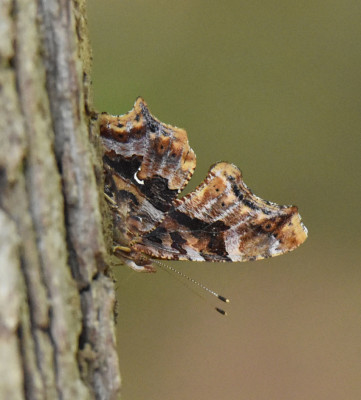
Actually, I wish I had seen the top sides of the wings on this butterfly. I now think it’s a very large Comma with a broken comma rather than a question mark. The forewings are not particularly “hooked.” Opinions are welcome: please leave a comment!
I was pleased to see both a white curved line and a white dot on the underside of one of the Anglewing butterflies on the sap tree. I haven’t seen as many Question Marks as I have Commas.
Unfortunately, after comparing it with images in my guide, I think this may be a Comma. The “dot” seems to be in the wrong place and the forewings are not particulary “hooked.” So I’ll have to keep looking!
This is some type of Comma, most likely an Eastern Comma.
What Is This Medium Sized Brown Butterfly or Moth With Many Eyespots On Its Wings?
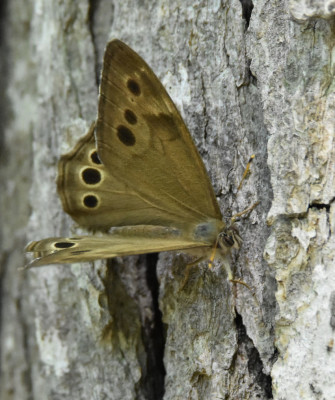
The “pearl” is probably the light ring around the dark eyespot.
The Northern Pearly Eye is a butterfly even though its light brown colour tricks many people into thinking it’s a moth. The habit of basking with its wings open, like a moth is more likely to do, may also be part of the i.d. problem.
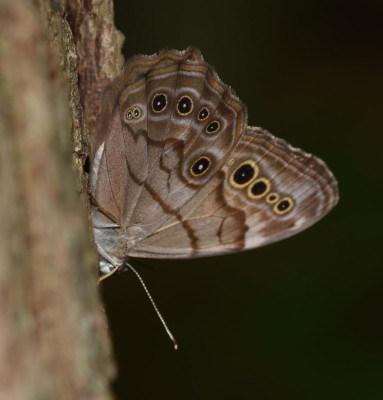
This is the view I usually have of the underwings. I rarely see them perched with their wings open. Notice the second dot of the 4 on the forewing is very small.
Each time I see one of these active butterflies, I try to get a clear photo, which can be tricky in the shade. In southern Ontario there are similar related butterflies like Appalachian Browns and Eyed Browns. I haven’t knowingly seen any but Northern Pearly Eyes. I’ll keep looking, though. Until today, I’d never knowingly seen any Compton Tortoiseshell’s either!
Do Mourning Cloaks Fly In the Summer or Only In the Spring?
I’m used to seeing Mourning Cloak butterflies in the very early spring. Sometimes I see them on sunny days even when there is still snow and ice on the ground. That’s because some over-winter as adults and emerge to lay eggs as soon as possible. Their caterpillars will eat the tree leaves almost as soon as they unfold.
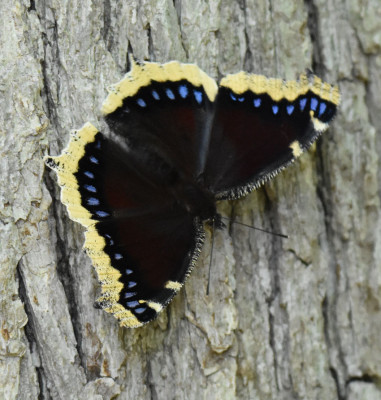
This one was not particularly battered and may have matured this spring. You can see it’s not at the sap right now: the butterflies were also looking for mates and rivals.
It’s now the first week of July, though, and one of the two Mourning Cloaks I saw today was not particularly battered. It is likely part of the second generation. If so, it probably pupated this spring and emerged not long ago.
A Mystery Moth, or Three, on the Sap Tree
Today I saw three small moths in and around the sap tree. I have no idea what any of them are called and I only managed to get photos of one type. (They all were quite differently coloured.) I’ll hope that some of them will be around the tree again later this week for another photo op.
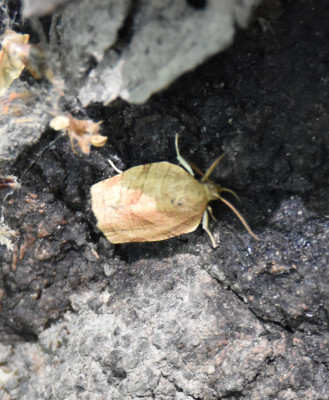
This very small moth looked like a piece of orange-brown leaf stuck on the bark.
Last year, I found quite a lovely large moth on the trunk of the tree. It didn’t appear to be after the sap when I saw it, but it may have been taking a sip the previous night. I still haven’t identified it yet, either. So many moths, so little time! At least now with my Peterson Field Guide to the Moths with its excellent illustrations I have a fighting chance.
Other Insects Sip Sap Too
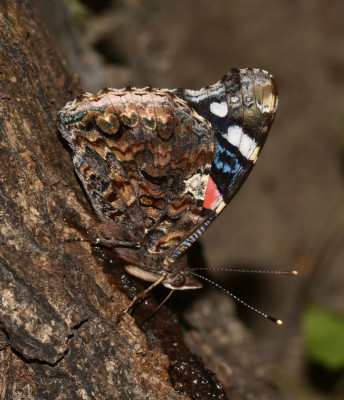
This Red Admiral is hard to recognize with its wings folded shut.
This year the wasps or hornets with the white heads and tails are back on the tree. They are quite aggressive towards the moths and butterflies and often chase them away. The tree trunk is quite heavily shaded most of the day so I don’t have any really good photos of them yet. One day, I hope to get a better view and identify them properly, too.
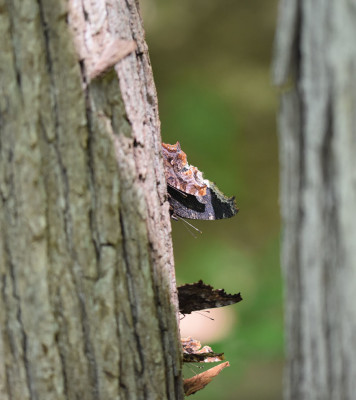
There are six butterflies on this part of the tree: keeping up with them while trying to get photos of the top wings and underwings while they keep flying off to chase rivals and find mates is a challenge!
So many wonderful things to watch and see and learn about—who says when spring migration ends there’s nothing to look for in the woods?!
Related Reading
- Butterflies Chasing Birds
- Butterflies of June Along the Credit River Valley
- Butterflies Abound on Bountiful Bergamot Blossoms
- The Butterflies of the End of Summer in Mississauga
- If I’m Hunting Butterflies Why Do I Have Such a Long Lens On?
Join In
Do you have a nearby tree that seeps sap? Have you found any interesting insects taking a drink? Please share your sighting with a comment.

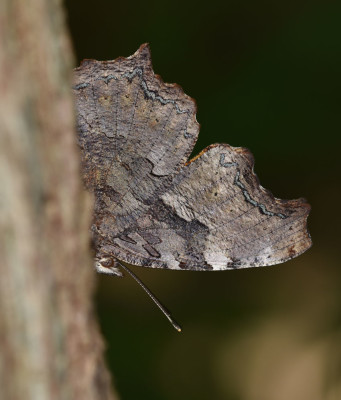
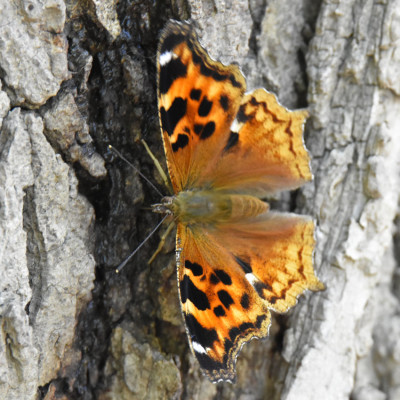
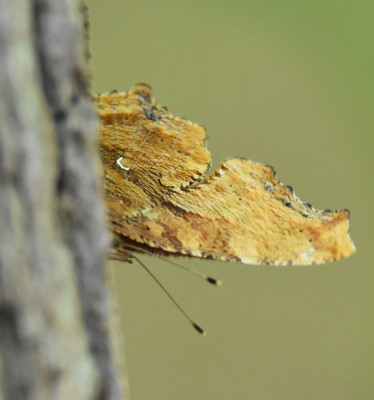
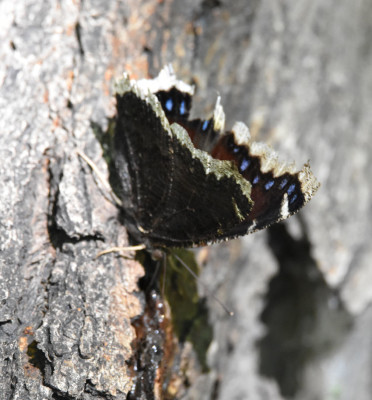
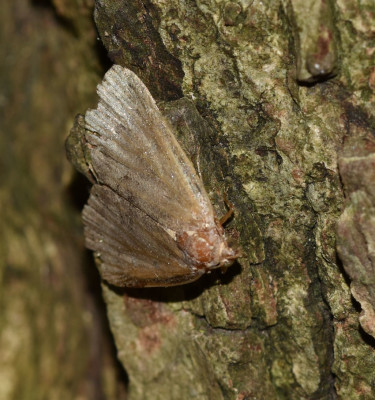
We recently had a tree cut down and now there is sap all over the top of the stump. It is covered with small black and orange butterflies that look a lot like tiny Monarchs. We live in northwest Indiana.
If you have a photo, if you put it up on BugGuide.net they may be able to id the butterflies. I’m not sure what kinds are most common in Indiana. Sounds beautiful though!